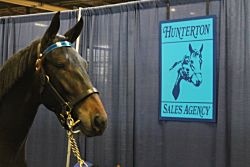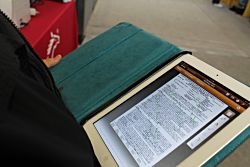Ontario-breds at Harrisburg get a boost from government panel
November 7, 2012,by Ellen Harvey, Harness Racing Communications
Harrisburg, PA — Things are looking up in Ontario for the first time in a long time, as a government-appointed panel announced the continuation of the sire stakes program at current levels.
Standardbred Canada Chair Tammy McNiven was selling yearlings at the Standardbred Horse Sale for her Twinbrook Farm when the news came through late Tuesday afternoon.

USTA/Ellen Harvey photo
Mythical Kemp (hip #778) sold for $65,000 on Wednesday after the announcement regarding the Ontario Sire Stakes’ continuation.
“The panel that was put in place by the liberal government to research how the horse industry can transition into an industry that the government wants to see, came out with a statement. It was demanded by the Standardbred breeders of Ontario. (The panel recommended) that the money for the sire stakes would be maintained from 2013 and beyond — a guesstimate of that is $22 million (a year).
McNiven says the “beyond” part is in question.
“That is unclear, wording is very unclear,” she said. “The wording says, ‘intend to carry on beyond 2013.’ They (the panel) is relaying to us that that is exactly what they want to have happen. They’re really pushing the government. The panel very much realizes how beneficial the horse industry is in Ontario and what an impact it has. They know they have to keep us there or the whole rural economy will collapse and it will transfer to the urban economy, too.”
The panel making the recommendation is made up of three former provincial government officials, from three different parties, all former provincial agricultural ministers.
“They understand agriculture,” says McNiven. “Even though they are from three different parties, they have similar values when it comes to the agricultural community.
McNiven thinks the announcement had an effect within minutes on sale prices at Harrisburg.
“The announcement came out at about 4:30 yesterday. I went to (Sales Manager) Murray Brown’s office and asked him to watch the internet. As soon as it was on the internet, Murray made the announcement and there was a round of applause and a buzz. We sold an Ontario-sired colt this morning and the people that bought it said it (the announcement) doubled the price (they were willing to spend).”
The announcement came too late for horses selling prior to Tuesday afternoon.
“We saw a 50 percent drop in sales that carried over here Monday and Tuesday,” says McNiven. “I’m not sure how much of an effect that has had today, but in our own consignment it has helped. I don’t know if you can put a dollar figure on it to see if it helped, but it didn’t hurt.
“The next three to six weeks is going to be very, very critical in Ontario for us to get more meetings with the Standardbred panel and make sure this industry is moving in the right direction. It’s good for breeders, it’s good for horse people and it’s good for racetracks and the public.”
McNiven said the panel’s recommendations are just that and the government is not bound by their announcement.
“The intent is that they want these recommendations followed through with,” says McNiven. “It’s a step in the right direction.”
Prices for Ontario-breds through Tuesday are:
Monday: 27 Horses Sold
Total: $906,000
Avg: $33,555
Tuesday: 37 Horses Sold
Total: $1,008,000
Avg: $27,243
Old horsemen learn new tricks
Not much has changed about horse sales in 100 years or so. Horses go in and out of the ring, people raise their hand, money and hopes are exchanged, dreams commence.

USTA/Ellen Harvey photo
New technology has allowed horsemen to have their sales catalog on an ipad.
The Standardbred Horse Sale, along with other Standardbred and Thoroughbred sales, now offers a catalog that’s not constructed of paper and ink, but rather metal, wires and semiconductors.
Trainer Fred Grant was one of many horsemen cruising the sales floor with a thin ipad in a portfolio case, replacing five pounds or so and pages and pages of catalog.
“It looks like a book shelf on the first page, you organize all the catalogs for all the years,” said Grant. “You don’t need to keep a stack of catalogs at home several feet high. I keep a short list of horses my owners are either selling or buying. I touch the screen and it comes up, you don’t need to mark the pages and flip through. You can use your finger or a stylus to write your notes on the page, same as you would write on the catalog. You can erase them, too.
“You can make a sticky note for a horse, you can use a specific color if you want. It’s not complicated. Even at my age (61), I can use it and you have last year’s catalog information right in there without carrying around a bookshelf.”
Day Three recap
At the end of day three of the Standardbred Horse Sale, Sales Manager Murray Brown summed up, “Once again, if you had what they wanted, they were willing to pay for it.
“I thought trotters were a lot stronger in relative terms. Pacing colts sold very well, especially anything that had a little glamour associated with it. Pacing fillies were very weak, they’re always the weakest segment.”
Asked if he thought there might have been an uptick because of the announcement on Tuesday that the Ontario Sire Stakes would continue for the indefinite future, Brown said, “Maybe a little, not huge. If I were doing it in numerical terms, I’d say 20 percent, which is pretty darn good. It went along really well.”
When asked if he thought the horses sold on the first two days of the sale would have seen a significant price increase had the sire stakes announcement come before they sold, Brown said, “Perhaps, perhaps. There weren’t all that many (64) Ontario horses in the first two days. No question they were hurt. One area where it might have helped would have been to bring more Canadians down here.”
The most striking statistic through the first three days of the sale was the 22 percent increase in sales prices for pacing colts. In 2011, 251 pacing colts sold in the first three days of the sale for an average of $37,945. This year, 253 colts sold for an average of $46,344.
Here are 2011 and 2012 numbers for day three of the sale this year versus last year:
Category-Sold-Gross- Average
2012 Pacing Colts-81-$1,500,000-$18,518
2011 Pacing Colts-81-$1,611,500-$19,895
2012 Pacing Fillies-101-$1,173,500-$11,618
2011 Pacing Fillies-75-$1,163,700-$15,516
2012 Trotting Colts-60-$1,375,500-$20,227
2011 Trotting Colts-66-$1,255,500-$19,023
2012 Trotting Fillies-60-$1,025,000-$17,083
2011 Trotting Fillies-59-$1,118,000-$18,949
2012 Totals-310-$5,074,000-$16,367
2011 Totals-281-$5,148,700-$18,323
- Opening session at Harrisburg: four pacing colts break $300,000 plateau (Monday, November 5, 2012)
The opening session of the Standardbred Horse Sale is in the books in Harrisburg, Pa., where a quartet of yearling pacing colts were hammered down for more than $300,000.
- Marc Hanover tops Harrisburg Day 2 at $275,000 (Tuesday, November 06, 2012)
After being the underbidder on colt pacer Joost Hanover, who sold for $300,000 on Monday, and colt trotter Shift Into Glide, who went for $250,000 during Tuesday’s (Nov. 6) session, Jones came away with colt pacer Marc Hanover for $275,000 as the auction’s second day came near an end.
- Ontario Sires Stakes purses maintained through 2013 (Tuesday, November 06, 2012)
The three-member OMAFRA (Ontario Ministry of Food, Agriculture and Rural Affairs) panel, charged with the transition of horse racing in Ontario, today issued a statement revealing their expectations regarding the purse structure of the Ontario Sires Stakes program.
- Cluster Hanover tops Thursday yearlings at Harrisburg (Thursday, November 08, 2012)
Through the first hundred or so yearlings sold at Harrisburg on Thursday (Nov. 8), the sales topper is hip #951, Cluster Hanover, who sold for $95,000 to Jack Darling.
